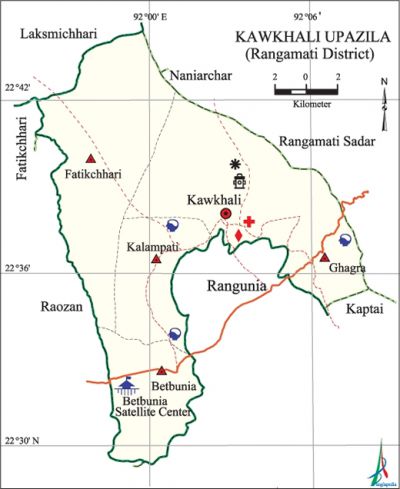Kawkhali Upazila (Rangamati District)
Kawkhali Upazila (rangamati district) area 339.28 sq km, located in between 22°29' and 22°44' north latitudes and in between 91°56' and 92°08' east longitudes. It is bounded by lakshmichhari and naniarchar upazilas on the north, rangunia and kaptai upazilas on the south, rangamati sadar upazila on the east, raozan and fatikchhari upazila on the west.
Population Total 59578; male 30516, female 29062; Muslim 21930, Hindu 1885, Buddhist 35640, Christian 83 and others 40. Indigenous communities such as chakma, marma, tripura and Tanchanga belong to this upazila.
Administration Kawkhali Thana was formed in 1976 and it was turned into an upazila in 1985.
| Upazila | ||||||||
| Municipality | Union | Mouza | Village | Population | Density (per sq km) | Literacy rate (%) | ||
| Urban | Rural | Urban | Rural | |||||
| - | 4 | 10 | 180 | 10330 | 49248 | 176 | 50.3 | 42.9 |
| Upazila Town | ||||||||
|
Area (sq km) |
Mouza |
Population |
Density |
Literacy rate | ||||
| 36.24 | 1 | 10330 | 285 | 50.3 | ||||
| Union | ||||
| Name of union and GO code | Area (acre) | Population | Literacy rate (%) | |
| Male | Female | |||
| Kalampati 76 | 14720 | 7084 | 7198 | 40.9 |
| Ghagra 57 | 30080 | 11719 | 11068 | 48.6 |
| Fatikchhari 38 | 19200 | 2715 | 2726 | 23.4 |
| Betbunia 19 | 19840 | 8998 | 8070 | 47.5 |
Source Bangladesh Population Census 2011, Bangladesh Bureau of Statistics.
War of Liberation Direct encounters were held between the freedom fighters and the Pak army at Betbunia and Balukhali on 9 December 1971 in which two freedom fighters were killed. On 11 December the freedom fighters attacked a military vehicle while it was crossing a culvert at Betbunia on the Rangamati Chittagong Highway in which two Pak army officers and the driver of the car were killed. There is a memorial sculpture at Ghagra.
For details: see কাউখালী উপজেলা, বাংলাদেশ মুক্তিযুদ্ধ জ্ঞানকোষ (Encyclopedia of Bangladesh War of Liberation), বাংলাদেশ এশিয়াটিক সোসাইটি, ঢাকা ২০২০, খণ্ড ২।

Religious institutions Mosque 32, temple 4.
Literacy rate and educational institutions Average literacy 44.2%; male 49.6%, female 38.6%. Educational institutions: college 2, secondary school 12, technical educational institution 1, primary school 56, kindergarten 2, madrasa 3. Noted educational institutions: Kawkhali College (1999), Ghagra College (2001).
Cultural organisations Library 1.
Important installations Betbunia Satellite Earth Centre, Police Special Training School, Chakma Rajbari, Helipad, Kawkhali' hanging Bridge.
Main sources of income Agriculture 63.42%, non-agricultural labourer 8.27%, commerce 9.89%, transport and communication 3.20%, service 9.83%, construction 0.33%, religious service 0.32%, rent and remittance 1.39% and others 3.35%.
Ownership of agricultural land Landowner 50.85%, landless 49.15%.
Main crops Paddy, ginger, turmeric, sesame, cotton, vegetables.
Main fruits Jackfruit, banana, pineapple.
Communication facilities Pucca road 99 km, semi-pucca road 47 km, mud road 147 km.
Cottage industries Goldsmith, blacksmith, weaving, bamboo work, cane work.
Hats, bazars and fairs Kawkhali and Ghagra bazars.
Main exports Sesame, cotton, ginger, turmeric, jackfruit, bamboo work, cane work.
Access to electricity All the unions of the upazila are under rural electrification net-work. However 40.7% of the dwelling households have access to electricity.
Sources of drinking water Tube-well 53.6%, tap 1.9% and others 44.5%.
Sanitation 30.6% of dwelling households of the upazila use sanitary latrines and 51.9% of dwelling households use non-sanitary latrines; 17.5% of households do not have latrine facilities.
NGO activities Operationally important NGOs are asa, proshika, CDS, CHCP, IDF, SAS, Hill Vission, Epsha. [Atikur Rahman]
References Bangladesh Population Census 2001 and 2011, Bangladesh Bureau of Statistics; Cultural survey report of Kawkhali Upazila 2007.
